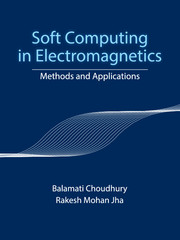Book contents
- Frontmatter
- Dedication
- Contents
- List of Figures
- List of Tables
- Preface
- Acknowledgments
- Abbreviations
- Symbols
- 1 Introduction
- 2 Soft Computing Techniques
- 3 Soft Computing in Electromagnetics: A Review
- 4 Bacterial Foraging Optimization For Metamaterial Antennas
- 5 PSO for Radar Absorbers
- 6 Characterization of Planar Transmission Lines Using ANN
- 7 Fault Detection in Antenna Arrays
- 8 Multi-Objective Particle Swarm Optimization for Active Terahertz Devices
- 9 Soft Computing based CAD Packages for EM Applications
- Author Index
- Subject Index
- References
1 - Introduction
Published online by Cambridge University Press: 05 July 2016
- Frontmatter
- Dedication
- Contents
- List of Figures
- List of Tables
- Preface
- Acknowledgments
- Abbreviations
- Symbols
- 1 Introduction
- 2 Soft Computing Techniques
- 3 Soft Computing in Electromagnetics: A Review
- 4 Bacterial Foraging Optimization For Metamaterial Antennas
- 5 PSO for Radar Absorbers
- 6 Characterization of Planar Transmission Lines Using ANN
- 7 Fault Detection in Antenna Arrays
- 8 Multi-Objective Particle Swarm Optimization for Active Terahertz Devices
- 9 Soft Computing based CAD Packages for EM Applications
- Author Index
- Subject Index
- References
Summary
Today's world can be best described by the term global village. Exploration, trade, commerce and scientific advancements have resulted in the breakdown of physical boundaries like mountains and oceans. While the credit for this virtual shrinking of the world is often attributed to the aforementioned factors, the biggest leap in this direction is a direct consequence of the discovery and subsequent improvements in communication systems—particularly wireless communication systems. The performance of these systems is an outcome of their constituent elements—elements whose designs are governed by electromagnetic (EM) formulations. Therefore, the contribution of electromagnetics in shaping the world as we currently know it, cannot be ignored. The demand for better communication systems has resulted in a demand for high performance electromagnetic structures, and as well as accurate, reliable and fast techniques to solve electromagnetic problems.
Almost in parallel with this demand for high performance in electromagnetics, a novel computing technique, called soft computing, is gaining popularity in a multitude of applications. This technique differs from conventional computing techniques by not relying on strict mathematical formulations. In fact, soft computing technique often seeks to emulate biological systems like neural networks, swarm behaviour, etc. Today, soft computing is increasingly being used to tackle non-linear, computationally intensive problems in engineering. Therefore, it is not surprising that these techniques find a comfortable niche in the field of electromagnetics, where there is a ubiquitous need for optimization.
Design and Optimization Scenarios
While the initial intention of soft computing was to address the problems in engineering design and optimization, the versatility of these techniques resulted in its application to almost all areas of day-to-day life including finance, humanities and medicine. A brief outlook on soft computing for these applications is discussed here.
Engineering applications
Soft computing plays an important role in providing cost effective and efficient means towards attaining the final objective of any engineering application, i.e., actual hardware realization. Hence, industrial applications of soft computing techniques in various fields such as microwave engineering, aerospace engineering, power systems, robotics, etc., are discussed here.
Design and optimization in microwave engineering applications is an important aspect that has been explored by various researchers.
Information
- Type
- Chapter
- Information
- Soft Computing in ElectromagneticsMethods and Applications, pp. 1 - 8Publisher: Cambridge University PressPrint publication year: 2016
